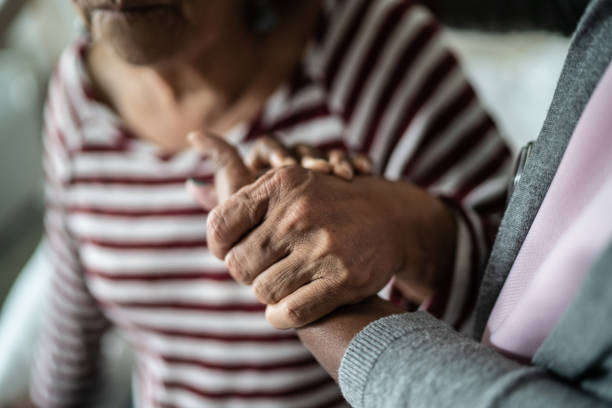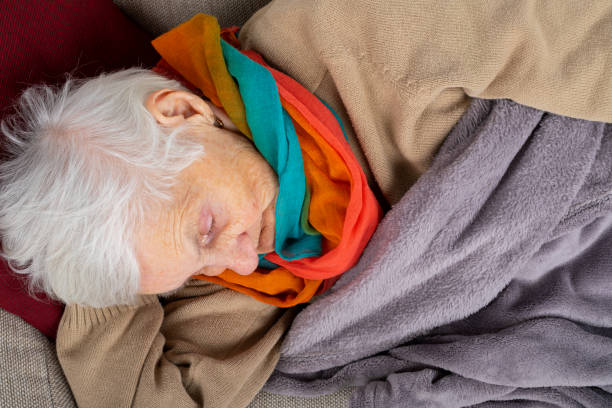Introduction

Millions of individuals worldwide are affected by Parkinson's, a neurodegenerative disorder. Managing its symptoms can be particularly challenging at night when certain symptoms may worsen. This blog post will explore effective strategies for improving communication with healthcare providers regarding nighttime symptoms of Parkinson's disease. By enhancing communication, patients can better convey their experiences and concerns, leading to more personalized and comprehensive care.
Understanding Parkinson's Disease
Before delving into communication strategies, it is essential to have a basic understanding of Parkinson's disease. Parkinson's disease is a chronic disorder that primarily affects movement. Common symptoms include tremors, rigidity, slow movement, and balance problems. However, the disease can also give rise to non-motor symptoms, such as sleep disturbances and cognitive difficulties.
Importance of Communication with Healthcare Providers
Clear and open communication between patients and healthcare providers is crucial in effectively managing Parkinson's disease. Patients can actively participate in decision-making and receive personalized care by sharing information about symptoms, concerns, and treatment preferences. Effective communication also enables healthcare providers to make accurate diagnoses and adjustments to treatment plans.
Challenges in Communicating Nighttime Symptoms
Communicating nighttime symptoms of Parkinson's can be particularly challenging due to various factors. These symptoms often include restless legs, difficulty turning in bed, frequent urination, and vivid dreams. Patients may experience anxiety, confusion, and sleep disturbances at night, making it harder to articulate their symptoms during daytime appointments. Furthermore, limited face-to-face consultation time and rushed appointments may hinder in-depth discussions about nighttime experiences.
Strategies for Effective Communication
Keeping a Symptom Diary: Maintaining a detailed symptom diary can provide valuable insights into nighttime symptoms, their frequency, and their impact on daily life. This record can be a reference during appointments, ensuring all concerns are addressed.
Preparing Questions in Advance:
Before appointments, patients should prepare a list of questions and concerns they wish to discuss. This helps ensure that important topics are noticed and allows for more focused and productive conversations.
Bringing a Support Person:
Having a trusted family member or friend accompany the patient to appointments can be immensely helpful. They can provide emotional support, help recall information, and advocate for the patient's needs.
Utilizing Technology: Leveraging technology can facilitate communication with healthcare providers. Mobile apps or telemedicine platforms can enable remote consultations and enable patients to share real-time updates about their symptoms.
Active Listening:
Actively listening to healthcare providers fosters a collaborative relationship. Patients should attentively listen, ask for clarification when needed, and engage in meaningful dialogue to ensure a thorough understanding of the recommended treatment approaches.
Enhancing Communication with Non-Verbal Cues
In addition to verbal communication, non-verbal cues can significantly enhance understanding between patients and healthcare providers. Patients can consider the following non-verbal strategies:
-
Maintaining eye contact to convey interest and attention.
-
Using hand gestures or visual aids to illustrate symptoms or experiences.
-
Demonstrating active engagement through nodding or facial expressions.
Building a Trusting Relationship
Establishing trust and rapport with healthcare providers is essential for effective communication. Patients can foster a trusting relationship by:
-
Expressing their concerns openly and honestly.
-
Sharing their treatment preferences and goals.
-
Showing appreciation for the healthcare provider's expertise and dedication.
Discussing Treatment Options
During appointments, patients should actively participate in discussions about treatment options. This includes:
-
Seeking information about various treatment approaches, including medication, physical therapy, or surgery.
-
Asking about potential side effects and risks associated with different treatments.
-
Discussing long-term management plans and follow-up care.
Seeking Second Opinions
In complex cases or when uncertain about treatment decisions, seeking a second opinion can offer valuable insights and peace of mind. Second opinions can provide alternative perspectives and additional treatment options, empowering patients to make informed choices about their care.
Advocating for Yourself
Patients should remember that they are the experts of their own experiences. Advocating for oneself involves:
-
Assertively expressing concerns and needs.
-
Seeking clarification or further explanation when information is unclear.
-
Requesting referrals to specialists or additional support services as necessary.
Support Resources
Several resources are available to support patients in improving communication with healthcare providers about nighttime symptoms of Parkinson's disease. These resources include:
-
Parkinson's disease support groups.
-
Online forums and communities.
-
Educational materials provided by reputable organizations.
-
Webinars or workshops on effective communication strategies.
Why is effective communication with healthcare providers crucial for managing nighttime symptoms of Parkinson's disease?
Effective communication with healthcare providers is crucial for managing nighttime symptoms of Parkinson's disease due to several reasons.
Parkinson's disease is a complex neurological condition that can present many symptoms, including motor disturbances, sleep disturbances, and medication-related complications.
Individuals with Parkinson's may experience nighttime symptoms like insomnia, restless legs syndrome, or REM sleep behavior disorder, which could greatly affect their quality of life and overall well-being. By effectively communicating these symptoms to healthcare providers, patients can receive appropriate evaluation and personalized treatment plans tailored to their needs.
Secondly, healthcare providers rely on accurate and detailed patient information to make informed treatment and management strategies decisions. Effective communication allows patients to describe the frequency, severity, and impact of their nighttime symptoms, enabling healthcare providers to understand the specific challenges faced during sleep and develop an appropriate management plan.
Additionally, communicating any changes in symptoms or treatment response over time is vital for healthcare providers to adjust medications, dosage, or other interventions accordingly. Collaborating with healthcare providers to manage nighttime symptoms can enhance the quality of life and outcomes of Parkinson's disease patients.
What are the nighttime problems of Parkinson's disease?

Parkinson's disease can present various nighttime problems that can significantly impact individuals' sleep quality. Some common nighttime problems associated with Parkinson's disease include:
Insomnia: Parkinson's patients may experience difficulty falling asleep or staying asleep throughout the night. Factors such as motor symptoms (tremors, stiffness) that disrupt sleep, medications that affect sleep patterns, or other comorbid conditions like depression or anxiety can cause this issue.
Rapid Eye Movement (REM) sleep behavior disorder: REM sleep behavior disorder is when a person acts out their dreams in a disruptive and vivid manner due to the loss of muscle paralysis during REM sleep. Sleep disturbances and an increased risk of injury to oneself or bed partners may be caused by this disorder, which is found more frequently in patients with Parkinson's.
Restless legs syndrome (RLS): RLS is characterized by an uncomfortable sensation in the legs, typically occurring during periods of inactivity or the night. People with Parkinson's disease have a higher prevalence of RLS, which can cause an irresistible urge to move the legs, leading to difficulty falling asleep or maintaining sleep.
Nocturia: Parkinson's disease can contribute to nocturia when individuals wake up at night to urinate more frequently. This can disrupt sleep and lead to feelings of fatigue and daytime sleepiness.
Sleep fragmentation: When you experience motor symptoms like tremors or stiffness and other nighttime issues, you may wake up several times during the night. As a result, your sleep becomes fragmented, and you may feel sleepy during the day, experience a decrease in cognitive function, and reduce your quality of life.
Sleep-related breathing disorders: Individuals with Parkinson's disease have an increased likelihood of experiencing sleep-related breathing issues, such as sleep apnea. Sleep apnea is characterized by sudden interruptions in breathing during sleep. This can lead to frequent interruptions, decreased oxygen levels, poor sleep quality, and daytime fatigue.
How can I help my Parkinson's patient sleep at night?

Helping Parkinson's patient improve their sleep at night can involve several strategies.
-
Patients must maintain a consistent sleep schedule by waking up and going to bed simultaneously every day. This can help regulate their internal body clock and improve the quality of their sleep.
-
To sleep better, ensure your bedroom is cool, quiet, and completely dark. You can achieve this by using curtains or blinds to block external light and reduce noise disruptions. If necessary, you can also use white noise machines or earplugs.
-
Regular exercise or physical activity during the day can promote better sleep at night. Encourage patients to consult their healthcare provider for appropriate exercise recommendations that accommodate their physical abilities and limitations.
-
Advise the patient to limit or avoid consuming caffeine (found in coffee, tea, soda, and chocolate) and other stimulants close to bedtime. These substances can interfere with sleep and exacerbate insomnia symptoms.
-
Parkinson's medications may have an impact on sleep patterns. Encourage the patient to discuss their medication schedule with their healthcare provider, as adjusting the timing or dosage may help alleviate nighttime symptoms and improve sleep quality.
-
To improve the quality of your sleep, you can try relaxation techniques such as deep breathing, progressive muscle relaxation, or guided imagery. These methods can assist in lowering stress, anxiety, and muscle tension, which in turn can improve your sleep.
-
Parkinson's symptoms, such as stiffness and muscle pain, can disrupt sleep. Encourage the patient to discuss pain or discomfort with their healthcare provider to explore appropriate pain management strategies, such as medication adjustments or physical therapy.
-
If nocturia is a problem, suggest strategies such as limiting fluid intake before bedtime, using the bathroom before sleep, and considering medication adjustments if necessary. Having a nightlight or a clear path to the bathroom can be useful.
-
If the patient experiences symptoms of sleep disorders like REM sleep behavior disorder or restless legs syndrome, encourage them to discuss these issues with their healthcare provider. Appropriate treatment options or medications may be available to alleviate these specific sleep-related problems.
-
Living with Parkinson's disease can be emotionally challenging, and stress or anxiety can affect sleep. Offer emotional support and encourage the patient to seek counseling or support groups to address their emotional well-being.
Conclusion
Improving communication with healthcare providers regarding nighttime symptoms of Parkinson's is essential for comprehensive and personalized care. By implementing strategies such as keeping a symptom diary, preparing questions in advance, and utilizing non-verbal cues, patients can convey their experiences more effectively. Building trusting relationships, discussing treatment options, seeking second opinions, and advocating for oneself further contribute to optimal care. Remember, effective communication is a collaborative effort between patients and healthcare providers to enhance the management of Parkinson's disease.
FAQs
How can keeping a symptom diary benefit communication with healthcare providers?
A symptom diary provides a comprehensive record of nighttime symptoms, helping healthcare providers understand their frequency and impact on daily life. It ensures that all concerns are addressed during appointments.
What should I do if I have trouble articulating nighttime symptoms during appointments?
Preparing questions in advance and bringing a support person can be helpful. The support person can provide emotional support and assist in recalling important information.
How can technology aid in communication with healthcare providers?
Technology, such as mobile apps or telemedicine platforms, allows for remote consultations and real-time symptom updates. This facilitates ongoing communication and reduces barriers caused by physical distance.
Why is active listening important in communication with healthcare providers?
Active listening promotes understanding and ensures that patients clearly understand the recommended treatment approaches. It also fosters a collaborative relationship between patients and healthcare providers.
Where can I find additional support and resources for improving communication with healthcare providers?
Parkinson's disease support groups, online forums, educational materials from reputable organizations, and webinars or workshops on effective communication strategies are valuable resources for patients seeking support and guidance.

